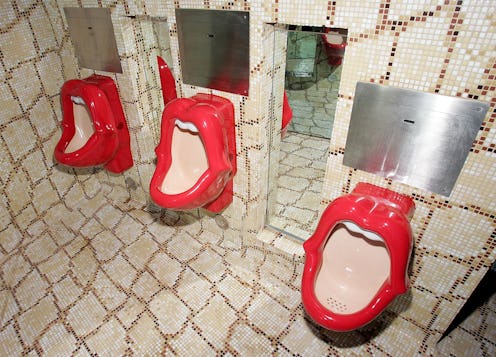Life
Is Bathroom Graffiti Sexist, Too?
In a world where it seems like sexism is everywhere, it turns out that not even bathrooms are the exception. According to a new study, graffiti in men's and women's restrooms is wildly different. Not only that, it's probably all thanks to internalized sexism. So thanks, patriarchy.
The study, which was published in the journal Gender, Place & Culture, studied graffiti in 10 bathrooms, half men's, half women's, at one unnamed college. The researchers found, surprisingly, that graffiti was more common in the ladies' room. Apparently women aren't as reluctant to deface property as people tend to think, at least in private. And they also found that while men's graffiti is comprised mainly of insults and sexual content, women's messages tend to be more relationship-focused, about personal feelings, or messages of support.
I can at least vouch for that last part making sense to me. I remember when I was in college, the women's restrooms in the library during finals were basically full of "You can do it!" messages. We all needed that; it was comforting, in a way (insofar as a public restroom can be considered comforting).
Pamela Leong, the researcher responsible for the study, theorizes that the discrepancies between male and female bathroom graffiti are probably due to internalized sexism. Women often use bathroom graffiti as a way to anonymously express things that might seem "unfeminine" or improper if shared directly, while men's graffiti reinforces hyper-masculine messages.
"Even in anonymous spaces some people are more equal than others," she writes. "[Graffiti] serve[s] to discipline gender ... and … reveal relationships of power."
It's worth pointing out, of course, that this study only looked at bathrooms at one university — which means it isn't so much definitive evidence about a possible widespread truth as it is a reflection of behavior by people at one particular school. Still, it does raise the question as to why male and female graffiti would be so dissimilar. Why is it that sexist differences follow us even into spaces where we are alone?
Possibly it has to do with the way gendered stereotypes are internalized in our society, to the extent that we self-police ourselves. Strict gender roles have harmful effects for all genders, and yet people cling to them tightly.
For instance, the belief that men have to be strong and that showing any weakness — physical or emotional — somehow devalues their male-ness and therefore their worth is terrible for men. It makes men isolated, unable to ask for support, and ill-equipped to handle their own emotions. Similarly, the expectation that women are naturally pleasant and kind makes it difficult for women to vent frustrations and anger. And yet both men and women reinforce these gender constructs every day, both intentionally and unintentionally.
So even though this study's scope is limited, it makes sense that, in such a sexist society where harmful, rigid gender roles are so deeply internalized, that graffiti in men's and women's bathrooms would be different.
Image: Giphy
